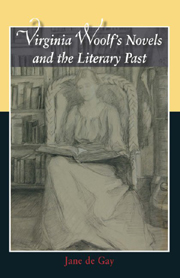Book contents
- Frontmatter
- Contents
- Acknowledgements
- Abbreviations
- Introduction
- 1 From Woman Reader to Woman Writer: The Voyage Out
- 2 Tradition and Exploration in Night and Day
- 3 Literature and Survival: Jacob's Room and Mrs Dalloway
- 4 To the Lighthouse and the Ghost of Leslie Stephen
- 5 Rewriting Literary History in Orlando
- 6 ‘Lives Together’: Literary and Spiritual Autobiographies in The Waves
- 7 Bringing the Literary Past to Life in Between the Acts
- Conclusion
- Select Bibliography
- Index
2 - Tradition and Exploration in Night and Day
Published online by Cambridge University Press: 12 September 2012
- Frontmatter
- Contents
- Acknowledgements
- Abbreviations
- Introduction
- 1 From Woman Reader to Woman Writer: The Voyage Out
- 2 Tradition and Exploration in Night and Day
- 3 Literature and Survival: Jacob's Room and Mrs Dalloway
- 4 To the Lighthouse and the Ghost of Leslie Stephen
- 5 Rewriting Literary History in Orlando
- 6 ‘Lives Together’: Literary and Spiritual Autobiographies in The Waves
- 7 Bringing the Literary Past to Life in Between the Acts
- Conclusion
- Select Bibliography
- Index
Summary
It is doubtful whether in the course of the centuries, though we have learnt much about making machines, we have learned anything about making literature. We do not come to write better; all that we can be said to do is to keep moving, now a little in this direction, now in that, but with a circular tendency should the whole course of the track be viewed from a sufficiently lofty pinnacle.
Woolf, ‘Modern Novels’ (Times Literary Supplement, 10 April 1919)Katherine Mansfield criticised Night and Day for being old-fashioned on its first publication in 1919, describing it as ‘a novel in the tradition of the English novel. In the midst of our admiration it makes us feel old and chill: we had never thought to look upon its like again!’ As a courtship drama, which reaches a comic conclusion in the engagement of two couples, the novel can be read as conservative not only for following an age-old narrative pattern but also for appearing to endorse the conservative social imperative of marriage. It thus seems to undo the progress made by Woolf's contemporaries and immediate precursors, from the so-called ‘New Woman’ novels to the radical sexual agenda of D. H. Lawrence. With its structured plot, conventional ending, rounded characters and setting in pre-war London, Night and Day sits oddly with modernist writings of the time (such as Mansfield's own work). It also reads as an aberration in Woolf's development as a novelist: it takes fewer risks with plot and characterisation than her first novel The Voyage Out; and is an unlikely predecessor to Jacob's Room, in which character and plot are fragmented and decentred.
- Type
- Chapter
- Information
- Virginia Woolf's Novels and the Literary Past , pp. 44 - 66Publisher: Edinburgh University PressPrint publication year: 2006



